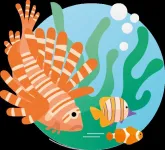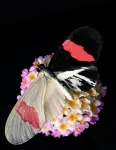(Press-News.org) AMHERST, Mass. -- New research from the Mechanical and Industrial Engineering Department at the University of Massachusetts Amherst, in collaboration with the Elaine Marieb Center for Nursing and Engineering Innovation, is helping to identify barriers to physical activity in nurses. Published in PLOS ONE, the study reports that the key factors influencing exercise include intrinsic motivation, certain types of social support, certain demographic identifiers and the use of health-tracking technology.
Nursing is a notoriously exhausting career, marked by irregular and long shifts and high physical demands. At the same time, prior studies show that about half of nurses fail to meet physical activity recommendations.
Joohyun Chung, associate professor in the Elaine Marieb College of Nursing and an author on the new paper, highlights how failing to meet physical activity recommendations negatively impacts nurses’ overall well-being. “This is connected to self-care,” she says. “When you work, it’s different [physical activity] than when you go swimming or skiing.” Considering that there are 4.2 million nurses in the U.S. and this field has high rates of burnout, improving nurses’ well-being is an important priority.
“And, indirectly, we want to improve the health care that they deliver to their patients,” says Muge Capan, assistant professor of industrial engineering at UMass Amherst and lead study author. “[Health] trickles down through the nurses to patient: If the nurse’s health is compromised, we know it impacts burnout, it impacts retention, it impacts diagnostic errors. If they are not at their healthiest, highest potential, then it impacts the care they give to their patients.”
It is very challenging for nurses to begin new healthy habits after they enter the workforce. So the researchers saw an opportunity to preserve or encourage new healthy physical activity habits in nursing students. “What we’re hoping is that they can take care of themselves first before they take care of others,” says Chung.
“This population is the future,” Capan adds. “If we understand the barriers to physical activity now in this population and target them with specific tailored solutions, then in the future, we can predict who is going to be at higher risk of continuing these [sedentary] behaviors. Maybe by preventing [inactivity], we are making an impact as they transition into the actual workforce.”
With this in mind, the research used validated questionnaires to identify the subsets of nursing students at greatest risk for physical inactivity and define the barriers they’re experiencing.
On an individual level, high intrinsic motivation to exercise corresponds to low barriers to physical activity.
Next, the researchers found a strong influence of social support on physical activity — and that not all social impacts are helpful. High emotional support (advice, encouragement) predicted a low barrier score, but high validation support (social comparison, competition, status) predicted a high barrier score.
“I am a member of a fitness app, for example, and you can give high-fives to each other or give encouragement,” says Capan. “That would be an example of emotional support, whereas validation support would be a leaderboard because you want other people to see where you are in the rank.” She believes that this kind of status comparison generates unhelpful stress, which creates more of a barrier.
Another important factor was family income. “We found that, for every $10,000 or greater in family income, the barrier score moved down significantly,” she says.
Finally, the researchers found that fitness trackers were a strong predictor. “If they were not tracking their activity, they were experiencing more barriers,” she says.
While it is difficult to draw direct cause-effect conclusions based on these results, it does give Capan and her team important insight into where to start focusing their efforts. “Hopefully, this is the beginning of a research branch that focuses on early recognition of barriers and addressing those in a targeted way, whether it’s a wearable device or platform or some sort of personalized health information technology,” she says.
Chung also sees the importance of shifting the way that nurses are trained. “It’s a more holistic way of thinking — how can they take care of themselves? How can they balance their work and life?” she says.
“This work is just one example of what can be done if we —if nurses and engineers — approach a problem together and bring in additional key expertise, like we did from the UMass Amherst Department of Kinesiology,” says Capan.
Contacts
Muge Capan, mcapan@umass.edu
Julia Westbrook, jwestbrook@umass.edu, 413-545-0149
END
New UMass study identifies factors that predict physical activity for nursing students
The ultimate aim is to help nurses prevent burnout by building healthy habits before they enter the workforce
2024-08-30
ELSE PRESS RELEASES FROM THIS DATE:
Auburn University secures two NSF grants to transform physics education
2024-08-30
Auburn University’s Department of Physics has been awarded two significant National Science Foundation (NSF) grants, marking a major step toward transforming physics education across all levels—from introductory courses to graduate studies. The grants, led by Assistant Professor Eric Burkholder, a specialist in Physics Education Research, aim to close the gap between traditional physics instruction and the complex problem-solving skills needed for real-world scientific challenges.
The cornerstone of these projects is the recognition that traditional methods of teaching physics—while ...
How hope beats mindfulness when times are tough
2024-08-30
A recent study finds that hope appears to be more beneficial than mindfulness at helping people manage stress and stay professionally engaged during periods of prolonged stress at work. The study underscores the importance of looking ahead, rather than living “in the moment,” during hard times.
Mindfulness refers to the ability of an individual to focus attention on the present, in a way that is open, curious and not judgmental. Essentially, the ability to be fully in the moment.
“There’s a lot of discussion ...
NASA, ESA missions help scientists uncover how solar wind gets energy
2024-08-30
Since the 1960s, astronomers have wondered how the Sun’s supersonic “solar wind,” a stream of energetic particles that flows out into the solar system, continues to receive energy once it leaves the Sun. Now, thanks to a lucky lineup of a NASA and an ESA (European Space Agency)/NASA spacecraft both currently studying the Sun, they may have discovered the answer — knowledge that is a crucial piece of the puzzle to help scientists better forecast solar activity between the Sun and Earth.
A paper published in the Aug. 30, 2024, issue of the journal Science provides persuasive ...
Biodiversity loss: Many students of environment-related subjects are partly unaware of the causes
2024-08-30
Worldwide survey by Goethe University FrankfurtFRANKFURT. Of the estimated 10 million, mostly still undiscovered species of flora and fauna on Earth, one million could become extinct in the next decades. This loss of biodiversity would have dramatic consequences, as animals and plants are providers of multiple services: They maintain ecosystems, ensure a more balanced climate on our planet, and supply us with food and active substances for medical drugs. Put bluntly: Without biodiversity, we humans will not survive.
That is why there is an urgent need for resolute political measures to counter the “sixth mass extinction” in Earth’s history. One group of people who are particularly ...
UTHealth Houston and Baylor College of Medicine collaborate on first CDC Injury Control Research Center in Southwest, established to study injury and violence prevention
2024-08-30
The only Injury Control Research Center in Texas has been established by the Centers for Disease Control and Prevention at UTHealth Houston in partnership with Baylor College of Medicine.
“I’m beyond thrilled to bring an Injury Control Research Center to Texas,” said Jeff Temple, PhD, director of the new center and associate dean for clinical research at UTHealth Houston School of Behavioral Health Sciences. “This collaboration between the community, policymakers, UTHealth Houston, and Baylor College of Medicine will undoubtedly save lives.”
An Injury Control Research ...
New findings on TB could change how we treat inflammatory disorders
2024-08-30
Tuberculosis is a confounding scourge. It’s the leading cause of death from infectious disease in the world, and yet it’s estimated that those deaths represent perhaps 5% of infections with Mycobacterium tuberculosis (Mtb). Antibiotics can take credit for saving the lives of some of those with Mtb, but a chasm nevertheless persists between the prevalence of infection and the targeted severity of its impact. A growing body of evidence suggests genetic vulnerabilities to TB account for that gap.
Now researchers from ...
Research Spotlight: A blood-based assay for the detection of IDH1.R132H-mutant gliomas
2024-08-30
Leonora Balaj, PhD, an investigator in the department of Neurosurgery at Massachusetts General Hospital and an assistant professor of Neurosurgery at Harvard Medical School, is co-senior author of a new paper in Nature Communications, Clinical Utility of a Blood Based Assay for the Detection of IDH1.R132H-Mutant Gliomas.
Bob Carter, MD, chair of Neurosurgery at Mass General, is co-senior author of the study. Syeda Maheen Batool, MD, an instructor in investigation in Neurosurgery at Mass General, is lead author.
Background:
Glioma represents the most common central nervous system cancer in adults. The current ...
Genomic dark matter solves butterfly evolutionary riddle
2024-08-30
[Note: High-resolution images related to this research available for download at this link. Caption and credit information provided.]
WASHINGTON (August 30, 2024) — A team of international researchers has uncovered a surprising genetic mechanism that influences the vibrant and complex patterns on butterfly wings. In a study published in the Proceedings of the National Academy of Sciences, the team, led by Luca Livraghi at the George Washington University and the University of Cambridge, discovered ...
Like people, vultures get set in their ways and have fewer friends as they age
2024-08-30
Key takeaways
Young griffon vultures move frequently between sleeping sites in different locations, interacting with many friends.
They get set in their ways as they age and roost in the same spots with the same individuals; older vultures follow the same paths.
Roosts act as information hubs; older vultures may have a more thorough knowledge of where to find food resources and less need to learn about them from other vultures.
If you’d rather be watching TV on your couch than dancing at the club, you might have something in common with aging ...
Not just a ‘bad guy,’ Tau also plays a ‘good guy’ role protecting our brains
2024-08-30
A study by researchers at Baylor College of Medicine and the Jan and Dan Duncan Neurological Research Institute (Duncan NRI) at Texas Children’s Hospital, reveals that the protein Tau – a key player implicated in several neurodegenerative conditions including Alzheimer’s disease – also plays a positive role in the brain. Tau mitigates neuronal damage caused by excessive reactive oxygen species (ROS) or free radicals and promotes healthy aging. The study was published in Nature Neuroscience.
“ROS ...
LAST 30 PRESS RELEASES:
Manta rays create mobile ecosystems, study finds
Study: Mixed results in using lipoic acid to treat progressive multiple sclerosis
Norbert Holtkamp appointed director of Fermi National Accelerator Laboratory
New agentic AI platform accelerates advanced optics design
Biologists discover neurons use physical signals — not electricity — to stabilize communication
Researchers discover that a hormone can access the brain by hitchhiking
University of Oklahoma researcher awarded funding to pursue AI-powered material design
Exploring how the visual system recovers following injury
Support for parents with infants at pediatric check-ups leads to better reading and math skills in elementary school
Kids’ behavioral health is a growing share of family health costs
Day & night: Cancer disrupts the brain’s natural rhythm
COVID-19 vaccination significantly reduces risk to pregnant women and baby
The role of vaccination in maternal and perinatal outcomes associated with COVID-19 in pregnancy
Mayo Clinic smartwatch system helps parents shorten and defuse children's severe tantrums early
Behavioral health spending spikes to 40% of all children’s health expenditures, nearly doubling in a decade
Digital cognitive behavioral treatment for generalized anxiety disorder
Expenditures for pediatric behavioral health care over time and estimated family financial burden
Air conditioning in nursing homes and mortality during extreme heat
The Alps to lose a record number of glaciers in the next decade
What makes a good proton conductor?
New science reporting guide published for journalists in Bulgaria
New international study reveals major survival gaps among children with cancer
New science reporting guide published for journalists in Turkey
Scientists develop a smarter mRNA therapy that knows which cells to target
Neuroanatomy-informed brain–machine hybrid intelligence for robust acoustic target detection
Eight SwRI hydrogen projects funded by ENERGYWERX
The Lundquist Institute and its start-up company Vitalex Biosciences Announces Strategic Advancement of Second-Generation fungal Vaccine VXV-01 through Phase 1 Trials under $40 Million Competitive Con
Fine particles in pollution are associated with early signs of autoimmune disease
Review article | Towards a Global Ground-Based Earth Observatory (GGBEO): Leveraging existing systems and networks
Penn and UMich create world’s smallest programmable, autonomous robots
[Press-News.org] New UMass study identifies factors that predict physical activity for nursing studentsThe ultimate aim is to help nurses prevent burnout by building healthy habits before they enter the workforce


